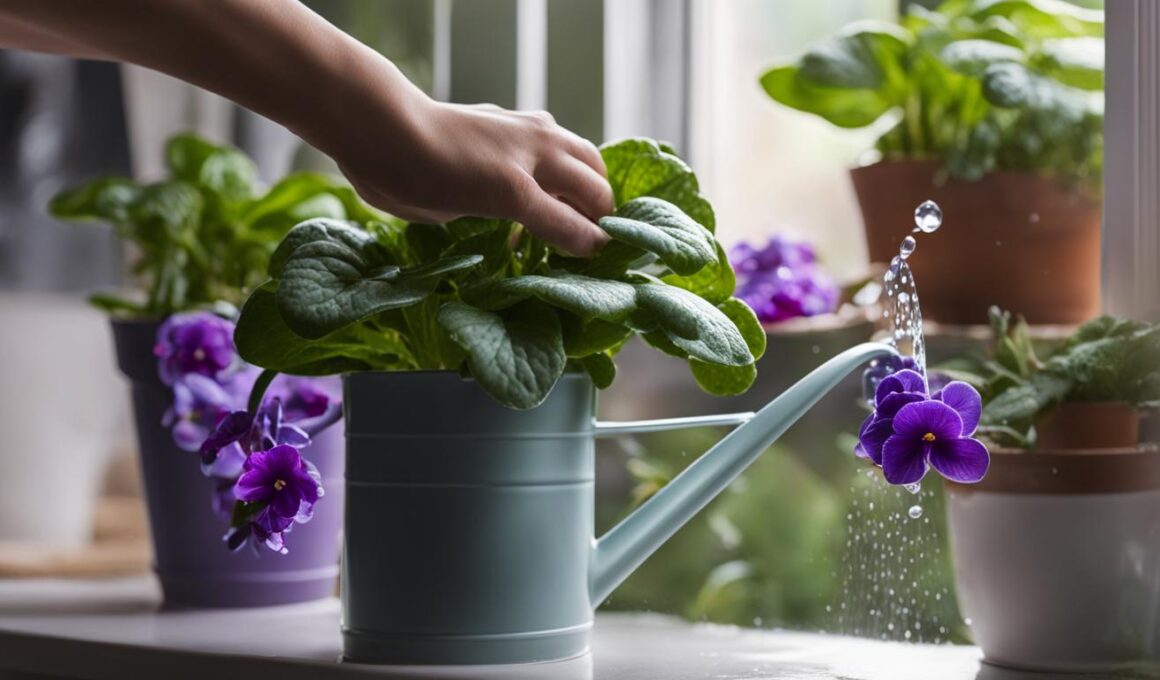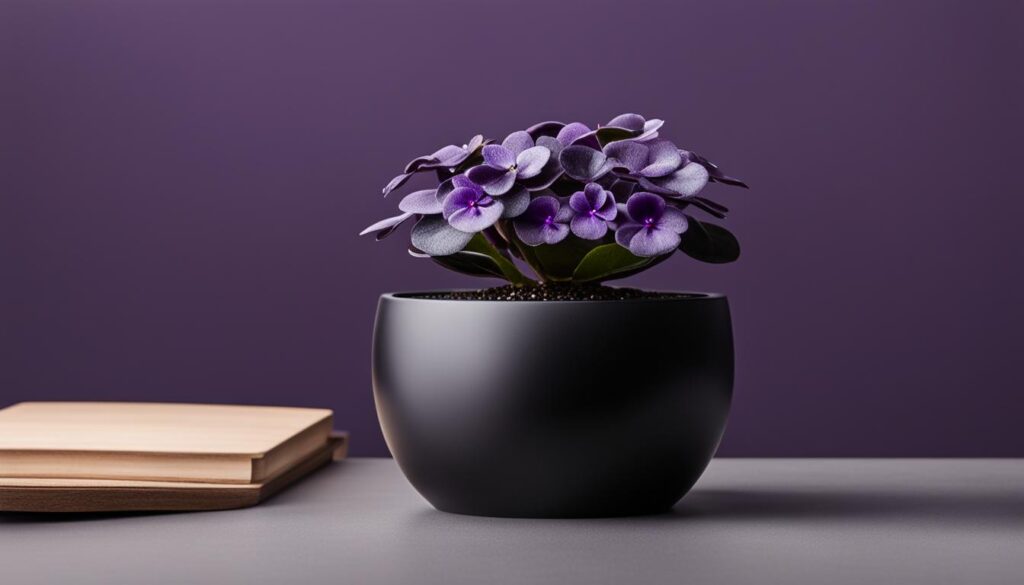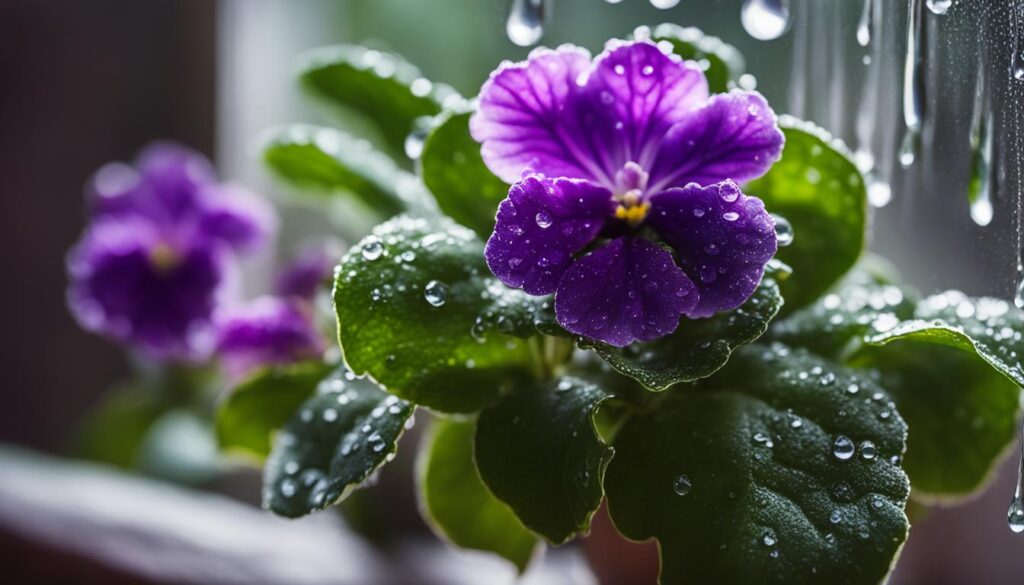Proper African Violet care begins with understanding the unique watering techniques that promote healthy and vibrant plants. Unlike many houseplants, African Violets thrive when watered from the bottom up. Naturally, this means that traditional top-down methods should be avoided in favor of bottom watering techniques. Some popular approaches include using self-watering pots, saucers, and wicking methods to maintain consistent moisture without risking over-watering and consequential leaf spots. In this guide, we will break down each method and provide essential tips for maintaining proper plant care.
Key Takeaways
- African Violets require bottom watering to maintain proper plant health.
- Popular bottom watering techniques include self-watering pots, saucers, and wicking.
- Use room temperature water to avoid shocking the plant’s roots.
- Monitor soil moisture closely to determine the appropriate watering schedule.
- Choose a light, porous potting mix that promotes proper drainage and nutrient absorption.
Understanding the Unique Watering Needs of African Violets
African Violets, unlike other popular houseplants, require special attention when it comes to watering. Their distinctive needs arise from their sensitivity to excess moisture on their leaves and susceptibility to certain diseases. In order to maintain healthy African Violets, proper watering techniques and keeping their soil at just the right moisture level are critical.
As opposed to the conventional top-down watering method, African Violets respond best when watered from the bottom up. Watering from the top may lead to the formation of leaf spots on the plant, compromising its aesthetic appeal. The primary objective while watering African Violets is to maintain a balance between moisture and aeration in the soil, promoting a healthy root system and preventing diseases such as Pythium, Crown Rot, and root rot.
Optimal soil moisture for African Violets is best described as evenly moist but not waterlogged. It is important to allow the soil to dry out slightly before watering again; this helps induce blooming and prevents diseases that arise from overly wet conditions. Use the following table to understand when and how to water African Violets according to their unique needs.
| Indicator | Action |
|---|---|
| Soil feels dry when finger is pressed into the mix | Water the plant |
| Soil feels moist but not soggy | Wait for a few days and then check again |
| Blooming has stopped or slowed down | Ensure soil is not too wet or too dry, adjust watering accordingly |
| Visible signs of diseases like root rot or Pythium | Reevaluate watering methods and consider repotting |
Besides following the unique African Violet watering needs, you must also remain vigilant about the plant’s overall health. Regularly inspect your African Violets for early signs of stress or disease, making adjustments as needed. By sticking to proper watering techniques and monitoring soil moisture, you can help your African Violets maintain a healthy and vibrant appearance.
The Bottom Watering Method for African Violets
Watering African Violets from the bottom ensures optimal plant hydration and prevents negative effects, such as leaf spotting. This section presents three effective techniques: self-watering pots, DIY saucer watering, and the wicking method.
Self-Watering Pots
Self-watering pots are a practical choice for maintaining an ideal moisture balance, minimizing the risks of over or under-watering. These pots transfer water directly to the soil through capillary action, ensuring that leaves remain dry and free from unsightly spotting.
Using a Saucer: The DIY Approach
A simple and effective DIY approach involves placing the African Violet pot in a saucer filled with water. This allows the plant to absorb moisture from the bottom up. Be sure to discard any excess water after the plant has absorbed it, to avoid keeping the soil overly saturated and causing complications like root rot.
Wicking: Continuous Moisture Supply
Opting for the wicking method means threading a water-absorbent material through the pot’s drainage hole and placing it into a reservoir of room temperature water. To ensure an adequate and consistent level of hydration, the material will draw moisture from the reservoir to the pot, while preventing over-saturation.
Here’s a comparison of the benefits associated with each technique:
| Method | Advantages |
|---|---|
| Self-watering pots |
|
| DIY saucer watering |
|
| Wicking method |
|
In conclusion, self-watering pots, DIY saucer watering, and the wicking method are all effective techniques for maintaining proper hydration through bottom watering. Choose the most suitable method based on your preferences, budget, and availability of supplies.
Identifying the Right Time to Water Your African Violets
Knowing when to water African Violets is crucial for the overall health of your plant. As each plant’s environment and watering schedule may vary, it is important to frequently check the soil moisture levels, making adjustments as needed.
By simply pressing a finger into the potting mix, you can assess its moisture level. If you find that the mix feels dry to the touch, this typically indicates that it is time for watering. However, if the mix feels moist, it is best to hold off on watering and check back in a few days.
- Consistently observe your African Violets’ environment for changes.
- Perform regular soil moisture tests.
- Adjust the watering schedule based on the moisture levels.
Establishing a regular watering schedule for your African Violets is essential for maintaining their health and vitality. To help simplify the process, consider the following table to assist in determining the appropriate watering schedule for your African Violets:
| Growing Environment | Signs of Dryness | Recommended Watering Frequency |
|---|---|---|
| Low Humidity | Soil dries out quickly | Every 3-4 days |
| Average Humidity | Soil dries out at a moderate rate | Every 5-7 days |
| High Humidity | Soil retains moisture for longer periods | Every 8-10 days |
Ultimately, understanding when to water your African Violets is essential for promoting optimal growth and preventing various plant health issues. By regularly performing soil moisture testing and adjusting the watering schedule accordingly, you can confidently care for your African Violets and keep them thriving.
Selecting the Best Water for Your African Violets
Providing your African Violets with the best water possible ensures that they will thrive and maintain their health. By considering factors such as water temperature, hardness, and quality, you can give your African Violets the proper environment for optimal living.
Temperature Considerations
Water temperature for African Violets should be room temperature to avoid shocking the plant’s root system. Using cold water can damage the roots, leading to leaves curling down or ring spots forming on the leaves. It’s essential to always provide room temperature water to protect root health and maintain the overall health of your African Violets.
Dealing with Water Hardness and Quality
When it comes to African Violet water quality, hard water is generally suitable as it does not adversely affect plant health. Soft water can cause increased salinity, which in turn affects the plant’s ability to absorb water and nutrients. If you have soft water issues, consider using distilled water instead.
Moreover, excessive chlorine levels in water can lead to leaf burn and reduced flowering in African Violets. If you suspect high chlorine content in your tap water, let the water stand overnight to dissipate the gas before using it to water your plants.
- Use room temperature water to avoid cold water damage.
- Utilize hard water or distilled water to avert soft water issues.
- Allow chlorinated water to stand overnight to reduce chlorine levels.
By following these tips, you can provide the best water for your African Violets and maintain their overall health and vigor.
Preventing Over-watering and Ensuring Proper Drainage
Preventing over-watering is a vital factor in maintaining the health of your African Violets. It requires well-draining soil and pots with adequate drainage holes. By employing the proper watering technique, you can allow the potting mix to dry slightly between watering sessions without ever letting the plant sit in standing water. Proper African Violet drainage and avoiding over-watering will lead to the long-lasting health and vitality of your plant.
In order to achieve appropriate drainage for your African Violets, consider these essential plant care tips:
- Choose pots with sufficient drainage holes: Opt for pots with multiple drainage holes to enable excess water to escape easily.
- Use well-draining potting mix: Utilize a light, porous potting mix specifically designed for African Violets, which allows water to pass through smoothly while retaining the necessary moisture for the plant.
- Avoid letting excess water accumulate: Discard any water collected in the saucer when waterings are complete and never allow the plant to sit in standing water for extended periods.
- Be mindful of watering frequency: Allow the potting mix to dry out slightly between waterings, preventing excessive dampness which can lead to root rot and other diseases.
Practicing a well-balanced watering schedule is key to ensuring the prosperity of your African Violets. By adhering to the above guidelines, you can maintain the proper moisture levels and avoid over-watering and root damage.
Avoiding Common Watering Mistakes
Proper care for African Violets requires attention to detail, especially when it comes to watering. Making common mistakes in the watering process can lead to unsightly water spots and over-watered plants, ultimately harming the overall health of your indoor plant. By understanding how to prevent water spots and recognizing the signs of over-watering, you can ensure optimal African Violet health and maintain an exquisite indoor garden.
Protecting Leaves from Water Spots
One major concern in the African Violet leaf care regimen is the prevention of water spots. Water spots on leaves occur when droplets are left on the foliage, which can cause unsightly blemishes. To avoid water spots, it’s crucial to employ bottom-up watering techniques and never leave water on the leaves. If the leaves do become wet, they should be dried immediately to prevent spot formation. Here are some tips for water spots prevention:
- Always water from the bottom, not the top, to keep leaves dry
- Use a soft cloth or paper towel to gently dab away any excess water on the leaves
- Ensure adequate air circulation around your African Violets to promote faster drying
Understanding Over-watering Symptoms
Over-watering is a common issue in indoor plant maintenance, and it’s crucial to recognize the signs before it leads to irreversible damage. A soggy, not just moist, potting mix is an indicator of over-watering. If the plant is excessively watered, root health may be jeopardized, leading to diminished blooming and an increased risk of disease. Monitoring soil moisture levels and adjusting the watering schedule accordingly can prevent these issues.
Pay attention to the following over-watering signs to ensure African Violet health:
- Yellowing or wilting leaves despite moist soil
- Root rot or a foul smell coming from the pot
- Mold or fungus growth on the soil surface
- Leaves that are soft and mushy to the touch
Understanding the importance of proper watering techniques, prevention of water spots, and recognition of over-watering symptoms can help maintain the health and beauty of your African Violets. By keeping a close eye on soil conditions and practicing these fundamental care tips, you’ll be well on your way to cultivating a thriving indoor garden.
Optimizing Plant Health with Correct Soil Moisture
Maintaining the right soil moisture balance is critical for African Violet health. The ideal potting mix should be light and porous to facilitate proper drainage and moisture retention, and can be enriched with perlite or vermiculite to improve these properties.
There are several factors to consider when creating the right African Violet soil moisture environment for your plants:
- Choosing an appropriate potting mix
- Monitoring soil moisture levels
- Adjusting the watering schedule
- Ensuring proper drainage
Choosing an Appropriate Potting Mix
The ideal potting mix for African Violets should be light and porous to allow for proper drainage and moisture retention. A mix containing peat moss, perlite, and vermiculite is a suitable choice for ensuring optimal plant health.
Monitoring Soil Moisture Levels
It’s essential to monitor soil moisture levels regularly to prevent over- or under-watering. To do this, insert your finger into the potting mix; it should feel moist but not soggy. If it feels too dry, water your plants immediately, and if it feels too damp, wait a few days before watering again.
Adjusting the Watering Schedule
Your African Violets’ watering schedule should reflect the plants’ needs instead of being fixed. If the soil is consistently drying out faster than anticipated, increase your watering frequency. Conversely, if the soil remains too damp, reduce the frequency of watering to prevent root rot and other diseases.
Ensuring Proper Drainage
African Violets require proper drainage to thrive. Make sure your pots have drainage holes at the bottom, and consider using pot elevation or saucers to prevent plants from sitting in excess water. This will help maintain the right soil moisture balance and contribute to optimal plant health.
The following table provides an overview of the factors discussed above and their impact on African Violet soil moisture:
| Factor | Description | Impact on Soil Moisture |
|---|---|---|
| Potting Mix | Light and porous mix containing peat moss, perlite, and vermiculite | Ensures proper drainage and moisture retention |
| Monitoring Soil Moisture | Checking the potting mix’s moisture level regularly | Helps maintain the right balance of moisture for optimal plant health |
| Watering Schedule | Adjusting the watering frequency based on the plants’ needs | Prevents over- or under-watering, and promotes healthy root development |
| Proper Drainage | Using pots with drainage holes and preventing plants from sitting in excess water | Ensures optimal soil moisture levels and minimizes the risk of root rot and other diseases |
By understanding and addressing these factors, you can create and maintain the proper African Violet soil moisture for your plants, ensuring optimal plant health and the longevity of your African Violets.
Are watering techniques included in the comprehensive care guide for African Violets?
Yes, watering techniques are a crucial component of the comprehensive care for African violets. Proper watering, such as using room-temperature water and avoiding wetting the leaves, is important for maintaining the health and vibrancy of these delicate plants. It’s essential to follow the guidelines for optimal growth.
Conclusion
In summary, following this African Violet watering guide will help you maintain healthy plants and enjoy their vibrant beauty. The key to successful hydration of these delicate flowers lies in bottom-up methods, using tools such as self-watering pots, saucers, or wicking. With a focus on proper technique, you can ensure your African Violets receive the attention and care they need.
Remember to use room temperature water to avoid shocking the root system and to allow the soil to dry slightly between waterings. This approach will enable your African Violets to flourish and minimize the risk of diseases. In addition, always ensure your potting mix is well-draining and offers the optimum balance of moisture retention to promote your plant’s health.
By adhering to these gardening tips and understanding the unique needs of your African Violets, you can create a thriving indoor environment for these captivating plants. With proper care and attention, these elegant blooms are sure to brighten any space and provide a rewarding horticultural experience.











